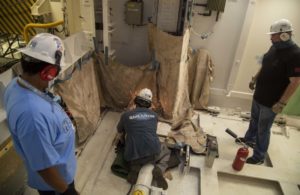This week the Chief of Naval Operations (CNO) provided an update on the status of the USS Gerald R. Ford, its delayed Advanced Weapons Elevators (AWEs), and lessons learned from the process.
“It’s the first in a series of three shock tests that we’re doing with the Ford as the first in the class. The first one, the ship did not sustain any appreciable damage from that first shock test, which was quite a large explosive charge. We’ll increase the intensity of the testing here over the course of the next month in two more shock trials,” Adm. Mike Gilday said July 20 during a pre-taped virtual session ahead of the Navy League’s Sea Air Space exposition in early August.
In June, the Navy said the Ford completed its first of three planned Full Ship Shock Trials (FSST) events off the East Coast. The service typically conducts shock trials of new ship designs using live explosives to confirm vessels can meet mission requirements under realistic conditions in battle at sea (Defense Daily, June 21).
Before shifting to the trails, the Ford underwent an 18-month Post Delivery Test and Trials (PDT&T) period it completed in April. The Navy previously said the FSST period would last for four months during the summer and be followed by an inaugural Planned Incremental Availability (PIA) this upcoming September for additional maintenance work that is expected to be finished by February 2022 (Defense Daily, May 5).

The post-shock trials PIA is expected to be used for additional modernization work and any maintenance or repairs due to the shock trials.
The Ford is the first carrier to execute these kinds of shock trials since the USS Theodore Roosevelt (CVN-71) in 1987.
“Having served on a ship that was damaged by two mines – this was years ago, during Desert Storm – I understand the impact – the potential impact and the value of those shock tests in understanding the survivability of our platforms and to give our – also to give our crews, to give our sailors confidence in the ships that we’re putting them on as they go to sea and potentially putting them in harm’s way that these are survivable platforms,” Gilday said.
He added the Ford did “very, very well in this first test” but noted the two remaining shock trial events.
Gilday reiterated the Navy plans to deploy the Ford in 2022, following the PIA.
The CNO also said shipbuilder and AWE builder Huntington Ingalls Industries [HII] has delivered seven of the 11 total elevators.
“We’ll deliver two more in early fall and then the remaining two by the end of 2021, so the elevators will be complete. And that’s going very, very well,” Gilday said.
In March, then-commander of U.S. Pacific Fleet and current head of Indo-Pacific Command Adm. John Aquilino said the Navy had completed nine of the 11 AWEs, but did not disclose the timelines for full acceptance (Defense Daily, March 22).
Gilday reiterated the Ford has been at sea for 50 percent of the time over the past year during its PDT&T period “and actually been serving as our carrier [qualifications] carrier off the East Coast for a number of months in 2020 and 2021. And so she has more operational time over the past year than nearly any other ship in the fleet, and she’s been performing very, very well. She’s been out there, you know, looking for high seas to operate in and operate those elevators. We’ve been providing or trying to put her in an environment where she can rigorously test all those systems, and they’ve gone very, very well.”
The CNO also named some lessons learned from the Ford process that the Navy is applying to newer ship classes like the Constellation-class frigate.
“One is that when you lock in the design, you lock in the design. And so when we start building the frigate, we are not looking at adding any new systems to that ship. The delivery of the frigate needs to be the Navy’s SpaceX. It needs to come out right, on time, within its budget, and with everything working right,” Gilday said.
He said the Navy also learned the importance of land-based testing on new systems before introducing them to the fleet.
“The ammunition elevators are an exceptional example of a painful process over the past four or five years. And so we are in the – in the ’21 budget we already have money dedicated to land-based test sites for the frigate so that we can perfect that technology before we – before we deliver it to the ship.”
Gilday said the third major lesson is “taking a much more deliberate approach with respect to introducing new technologies to any platform.”